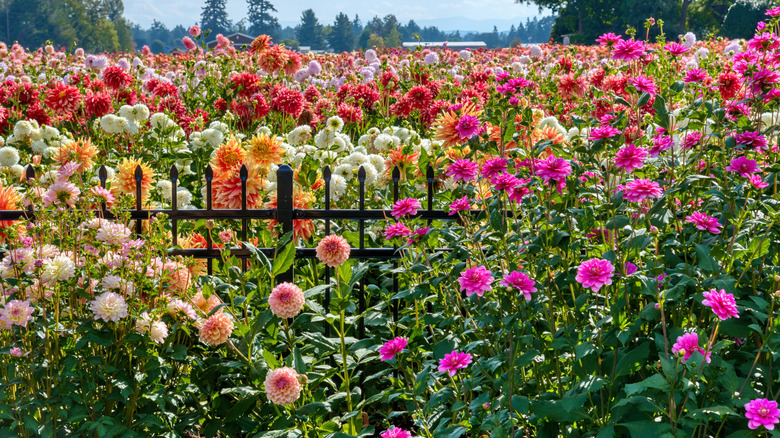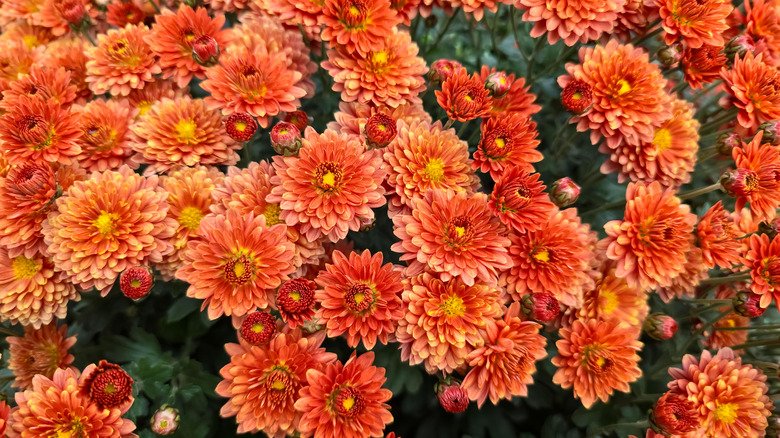The Gorgeous Perennials To Grow In Your Garden For An Autumn Bloom
As summer's heat fades and the days shorten, the garden often feels like it's taking a deep breath, preparing to rest over the winter. It's a time when many flowering plants start to lose their color, signaling the end of the growing season. But this transitional period doesn't have to mean the end of your garden's blooms. It's actually the perfect opportunity to introduce a second act with a few select perennials that really shine in the cooler weather. Two of the best options for flowers that bloom into the late fall are dahlias and chrysanthemums, both known for their ability to bring a lasting display of color.
These plants stand out in any garden as the weather starts to cool. Dahlias, with their variety of shapes and sizes, from single-petal varieties to massive, dinner-plate sized blooms, offer a special beauty that's hard to match. Chrysanthemums, or mums, create a blanket of dense color that brightens up any outdoor space. By growing these flowers, you can defy the idea that gardening is over after August. Instead, you can keep your garden colorful well into the crisp days of fall.
A dazzling display of dahlias
Dahlias are hardy in zones 7 to 11. They grow from tubers, and they're masters of providing late-season blooms. With a bit of attention early in the season, they will produce a wealth of blooms that can last from mid-summer until a hard frost. To begin, plant the tubers in late spring after the last threat of frost has passed and the soil has warmed to at least 60 degrees Fahrenheit. They need a location with ample sunlight, ideally six to eight hours a day, and well-draining soil to prevent the tubers from rotting.
During the growing season, consistent watering is a must, especially in dry weather. Tall varieties will need staking to support their heavy flowers and prevent stems from breaking in the wind. One step that will help you get a lot of flowers is to pinch the main stem when the plant is about a foot tall to encourage bushier growth. As flowers fade, deadheading is a must. By removing spent flowers, you redirect the plant's energy toward growing new buds, extending the blooming season. After the first heavy frost blackens the foliage, it's time to cut back the stems and carefully dig up the tubers for winter storage in colder climates.
Making mums the star of your autumn garden
Mums are almost synonymous with autumn gardens. Their compact, mounded form and explosion of colorful flowers make them a popular choice for both containers and garden beds; they're hardy in zones 3 to 9. To get the most out of your fall mums, it's best to plant them in the spring, allowing them to establish a strong root system before they bloom in the fall. Choose a spot that gets at least five to six hours of sunlight and has well-drained soil. Like dahlias, mums do not like to be waterlogged, so be sure the soil has sufficient drainage.
While many people buy blooming mums in the fall, those are often florist varieties that may not be hardy enough to make it through a cold winter. Look for perennial garden mums if you want them to return in the spring. To promote a bushy shape and prevent leggy growth, pinch back new shoots several times throughout the spring and early summer, stopping around July. This practice helps the plant develop a rounded shape and produce more flowers in the autumn. After the flowers fade, don't cut the mums back to the ground. The old stems and leaves will insulate the plant, providing a protective layer that helps it survive the winter. When the ground starts to freeze, applying a 4-inch layer of mulch to your plants acts as an insulating blanket. This layer keeps the soil from repeatedly freezing and thawing, protecting the plant's roots from damage.


